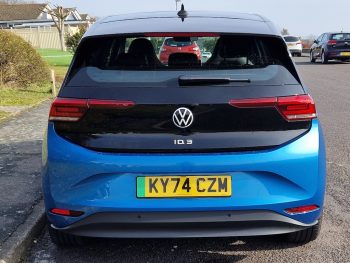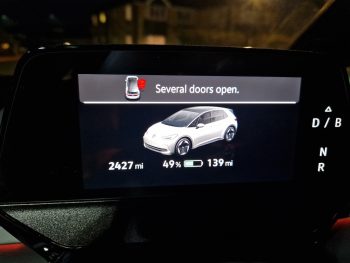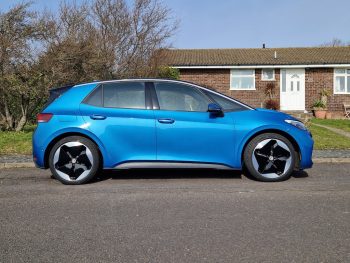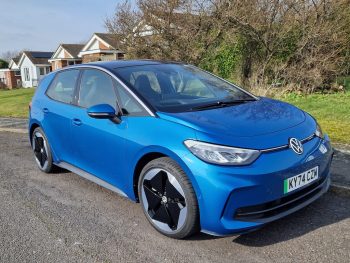Fleet World Fleet: Volkswagen ID.3
John Challen reports back on our Volkswagen ID.3 long-termer.
Volkswagen ID.3 Pro S 77kWh
OTR PRICE £43,275 | BiK 3% | RANGE 346 miles | ON FLEET RANGE 335 miles | EFFICIENCY 3.6mpkWh
Report 4:
 Despite hearing numerous tales of multimedia meltdowns in various Volkswagen ID models, I’ve been fortunate enough to avoid them in nearly a year of running firstly an ID.7 and now an ID.3.
Despite hearing numerous tales of multimedia meltdowns in various Volkswagen ID models, I’ve been fortunate enough to avoid them in nearly a year of running firstly an ID.7 and now an ID.3.
That all changed the other morning when I was tasked with taxiing Challen Jnr to a GCSE revision session at his school. As we entered the car, we were faced with the black screen of doom – with the sound of Spotify the only sign of life. Fortunately, it wasn’t a long journey and not one that required navigation, changing the climate or anything else. But it did make me realise how I – and, I’m guessing, we all – rely on the information contained within that 12.9-inch touchscreen. It’s even the only place that shows the time in the ID.3!
Long story short, the issue righted itself after I left the car for a bit when I returned home – by the time I headed out later that morning, it was business as usual. But the failure did mean that (first-world problem, I know) I had to rely solely on the mirrors and the actual surroundings to reverse onto the driveway because the reversing camera was essentially rendered useless. And it also meant that I was forced to listen to a load of ads in the middle of a podcast because I couldn’t skip them via the screen.
As I said, it’s no hardship really – and probably a reminder of how we shouldn’t always expect the technology to be there all the time. I actually sometimes quite like a stripped-out, no-nonsense car when it comes to tech (Mazda’s MX-5 is probably the best/most recent example I can think of), but that’s different because the added extras aren’t there in the first place to get used to!
I’m happy to report that the screen glitch has been the only issue in recent weeks and the ID.3 has been happily going about its business. The economy figure continues to improve and has just nudged up to a 3.6mpkWh average over nearly 3,000 miles. The continued warmer weather will hopefully help boost that further, along with the extended range, which continues to edge closer to the WLTP combined figure.
Report 3:

Meanwhile, the same screen that is relaying the information about my driving performance has thrown up some other interesting thoughts. For one thing, it has amused me with various messages that pop up on entering and leaving the car, my favourite being ‘Several doors open’. I don’t know why it tickles me so much, I think it’s just the very particular wording of the information. Technically it is correct, but why not just go with ‘Doors open’, because it indicates which ones they are with a little graphic alongside?
Staying with the display, in a day and age where massive ones can dominate the driver’s area, it’s encouraging to see one that is compact (5.3-inch) by comparison. Not only that, but it has the ability to display a lot of information (speed, ADAS, battery SOC and efficiency and trip details) in a very clear and sensible way.
Report 2:

Some of the concerns people might have with cars such as the ID.3 is how they perform out of towns – which is probably seen as their natural habitat. But I’ve completed a few motorway runs up and down the country now and it’s a dream. There’s little cabin noise, save for a bit of grumble coming from the tyres, but that’s almost a given with pretty much every car these days. Especially the concrete section of the bottom of the M25, but we’ll save that rant for another day.
Equally, the ID.3 is more than at home in towns and cities. Easy to manoeuvre, helped by a tight turning circle and light steering – but still with a bit of feel. A few trips along the road to Brighton has seen the ID.3 come into its own with the ability to squeeze into small gaps and navigate roads where people have double-parked – standard for the Sussex city, to be honest.
Visibility is good, even without the front and rear cameras, which makes the job even easier!
First report:

As the smallest member of Volkswagen’s electric family, the arrival of the ID.3 Pro S left me fearing the worst with five of us, including three growing Challen Jnrs.
In reality, I – and my passengers – have been seriously impressed with the relatively cavernous interior of the ID.3 as well as the quality and switchgear, which has undergone a bit of an upgrade since the original model. The main criticisms were that things had been stripped too far back and the controls were difficult to operate. Now, having taken a leaf out of the ID.7’s layout, elements such as volume and mirrors are much easier to adjust.
It’s often an overused phrase, but our ID.3 is probably close to fully loaded. As well as the standard kit there’s adaptive chassis control (£955), assistance plus (£2,240) and interior plus (£3,865) packs, carpet mats (£105), panoramic glass roof (795), variable luggage floor (£75) and a transport hitch for a bicycle carrier (£365). Add in the £810 colour scheme and this particular model comes in at £52,485 – quite the premium over list.
Out on the road, first impressions are positive, although the claimed economy of 4.2mpkWh doesn’t seem to be in reach right now. but most of the journeys in the ID.3 have been in and around town, which might explain that. With a few longer runs coming up, I’m hoping that the needle will shift a bit there soon.














Leave a comment